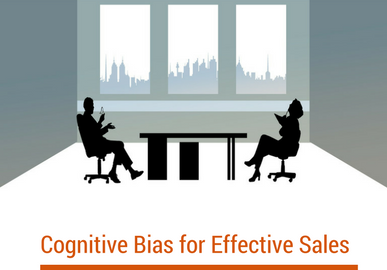Human psychology is an intriguing dimension of science, which is as unique as a DNA. It’s formulation and fabrication is highly driven by our own set of thoughts, past experiences, social reality and many more elements which exhort us to think on emotional, rather than just logical grounds.
Such biases which interfere with the decision-making process and alter our perception are called as cognitive biases. Cognitive bias is a blanket term, which highlights and talks about all aspects of human behavior, highly responsible for devising a thought process, irrespective of logical inference.

As sales professionals, we at times do not realize that these psychological judgments impact our sales graph. Identification of one’s inclination and the areas of improvement where one tends to deviate from logical explanation are crucial to the success of every sales professional, trying to rise above the ordinary. While turning the tables around, sales personals can use these biases to their own benefit to deliver better and faster sales.
Here’s how various cognitive biases can be used for effective marketing and enhancing your consumer base:
- The ambiguity effect
Here’s the scenario: you have to choose between a restaurant which you have tried earlier but isn’t your favorite and another one is a completely new venture, waiting to be explored. Which one would you pick? Probably the first one!
This is where ambiguity effect comes into play where a person is not sure about the choice to make but still decides to take a decision, with references from past experiences. The ambiguity effect impacts decision-making process due to lack of sufficient information.
Takeaway for Sales: Efficiently educating customers about business solutions, products and services can make them believe or draw their inclination towards the brand.
- The anchoring effect
Anchoring effect works on the principle of first impression and how our mind is biased by it. A famous quote says, that “Don’t judge a book by its cover”. However, it is a human tendency to discard this philosophy and draw perceptions depending upon first impressions. Either through comparison or minute segments of information that we receive, our mind automatically personifies an anchor and uses it further to build a brand image and influence the decision-making process.
Takeaway for Sales: The anchoring effect is one of the most used techniques by sales professionals to draw the attention of customers. While approaching a prospect for the first time, make sure you are ready with an excellent sales pitch and information to impress the recipient. With the help of CRM software, you can conduct an entire research on the prospect. Study his behavioral characteristics and preferences to modify your selling tactics and set a positive tone with the customer.
- The Bandwagon effect
Another aspect of human psychology is highlighted here that, we tend to naturally gravitate towards a popular trend. It refers to a ripple effect caused by the popularity of a brand/product which encourages people to join the league, making them believe as it’s the best solution.
Takeaway for Sales: Social interactions and media are powerful tools which can influence people in much bigger numbers than estimated. Spreading a positive word of mouth out in the market will effectively help in drawing eye-balls towards the brand.
Need any company CRM Software.
